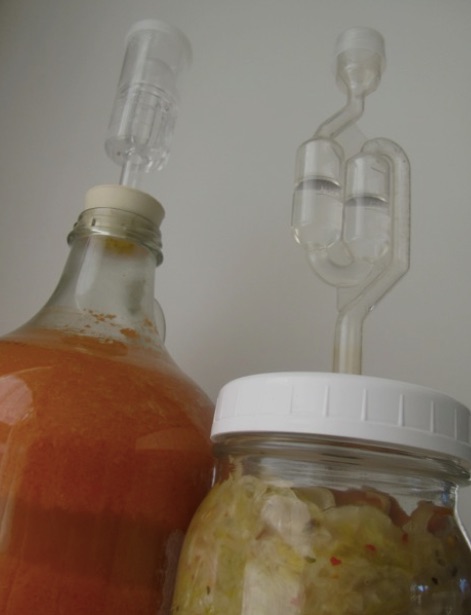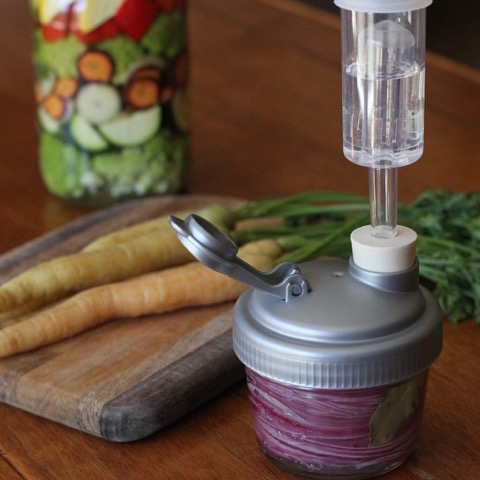In fermentation an airlock is a set up that allows the carbon dioxide gas created as the bacteria break down the sugars and starches to escape the fermentation vessel, without letting new air into the environment. They have been common standard equipment in alcohol fermentations but are fairly new to the lactic acid fermentation scene. This will talk about using an airlock with fermented vegetables. There are many ways to achieve this airtight environment and it often involves a bit of water. The ceramic water-seal crocks were likely one of the first ways that humans figured out that a simple ring of water would trap the air.
Airlocks like the ones pictured above also use water as the seal. The carbon dioxide bubbles out through the water but the outside air can’t find a path back through the water and into the ferment. Simple ones like these have been used in alcohol ferments for years but as lactic acid fermentation has gained popularity many folks have adapted these to use on canning jars.
These systems take most of the babysitting out of the curing time during the fermentation. We admit to setting ferments in their air lock topped jar and forgetting them—with delicious results. That said, its only fair that you know all ferments have a mind of their own (just like kids). So while you think they are safely sleeping in bed, they just might be under the covers reading ghost stories with a flashlight. Then they get scared and there is a whole lot of excitement…same with the microbes.
If your ferment is particularly active and your jar is particularly full this moving brine may just bubble right out of your ferment. When the ferment appears to be “making” brine what is really happening is it is expanding due to the trapped carbon dioxide. This movement in the brine is sometimes called a “heave” or a “surge.” Therefor weights are another important piece of the worry-free ferment as they help keep the veggies in place during the most active phases of fermentation. We have found out ferments are infinitely more successful if we manage the air pockets. Even if the oxygen is not present and the vessel is completely sealed in these pockets the flavor can have a bitter quality if they aren’t pressed down. This brings us back to using small weights or simply opening your ferment as needed to press the veggies back down under the brine (with a clean utensil) before sealing it up again for more fermentation.
So, the second part of the title—should you use an air lock? The answer is it depends. It depends largely on you, your style, your setup, and your comfort level with fermentation. Fermentation is an ancient, very low-tech, and forgiving process, but it’s important to note that LABs (the friendly bacteria we talked about earlier) are happiest and most productive in anaerobic environments (again, ones without oxygen). Enter the airlock systems, which allow carbon dioxide to escape from your container, while keeping oxygen out—creating the anaerobic sweet spot needed to foment your ferment. This takes some of the babysitting out of the process, allowing you to forget about your jar a bit while the good bacteria process the fruits and veggies. While airlocks aren’t necessary, they can give newbies the confidence they need to get hands-on fermenting experience. They also made to fit nicely on any wide-mouth Mason jar, making them a cost-effective solution with a relatively small footprint.
It is important to note that not airlocks are foolproof. Though it’s unlikely, even with an airlock, scum (mold and yeast) can still make their way into the jar. We have built these troubleshooting pages just to help you out. If you want to master vegetable fermentation and feel confident in fermenting any vegetable with or without an airlock be sure to check out our fermentation masterclasses, especially Mastering Fermented Vegetables, where we look at all kinds of fermentation vessels and their pros and cons.




